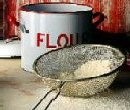Guar gum could boost potential for chestnut flour in gluten free foods, says study
The study, published in the International Journal of Food Science & Technology, found that guar gum at 1% addition seems to be the most promising gum to improve [the] bread-making aptitude of chestnut flour doughs because of its high stability in the mixing stage, its high starch stability and heat resistance to dough processing and its elasticity.
Gluten-free growth
The findings from the new study could help chestnut flour products break into the already booming gluten-free market.
Since it was valued at around $580m in 2004, the gluten-free market has grown at an average rate of 29% per year, and was worth $1.56bn in 2009, according to a report from Packaged Facts – which estimated the market could be worth up to $2.6bn by next year.
In order to develop better quality gluten-free breads, a number of alternative flour types have been investigated, including corn, rice, bean starch, buckwheat, and chestnut.
However the many gluten-free flours cause problems because they lack the correct viscoelastic properties for bread production – something that is normally provided by gluten.
Objectives
Althoughchestnut flour has properties such as the absence of gluten, low protein content and a high amount of essential fatty acids, the lack of gluten proteins means that it is difficult to produce certain products without the addition of additives such as hydrocolloids – “which imitate the viscoelastic properties of gluten.”
“The main aims of this work were to prepare chestnut flour doughs with different contents of arabic gum, carboxymethyl cellulose, guar gum and tragacanth gum ... to study the rheological behaviour by analysis of the corresponding parameters from steady-shear, oscillatory, temperature sweep and creep-recovery tests,” said the researchers, led by Ramon Moreira from the Universidade de Santiago de Compostela, Spain.
Study details
Moreira and his colleagues noted that the use of hydrocolloids with thickener and stabiliser properties – such as arabic gum, carboxymethyl cellulose, or guar gum – in gluten-free formulations “seems to be a promising alternative for the development of high-quality products.”
They found that the rheological properties of chestnut flour doughs during mixing, heating and cooling tests were significantly modified by the addition of arabic gum, carboxymethyl cellulose, guar gum and tragacanth gum. Guar gum, they concluded, offered the most promising results.
Source:International Journal of Food Science & Technology
Volume 46, Issue 10, pages 2085–2095, doi: 10.1111/j.1365-2621.2011.02720.x
“Rheological properties of commercial chestnut flour doughs with different gums”
Authors: R. Moreira, F. Chenlo, M.D. Torres
















